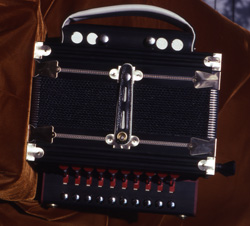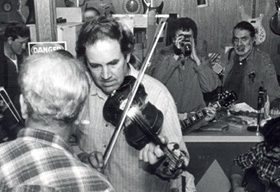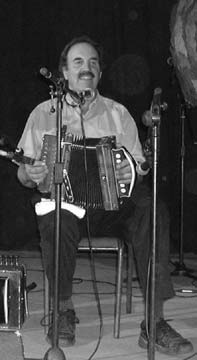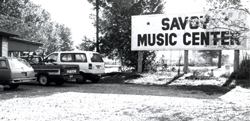Table of Contents
Introduction
Profiles of Masters and Apprentices

Eunice, Louisiana, is the home of Marc Savoy, whose art of building and repairing button accordions has been instrumental in the preservation of Cajun music and the folk traditions surrounding its performance and appreciation here in Louisiana and elsewhere. Conservation of Cajun culture has been an important element in Marc's life since his youth. He observed his classmates losing their heritage through assimilation, but resisted those changes himself. Marc's statement about his friends' loss of interest in their cultural traditions has been frequently quoted, "To me, it was as though they were giving up a delicious bowl of gumbo for a cold and tasteless hot dog." The insight that Marc exhibits about the importance of one's heritage is due in part to his grandfather's love of Cajun music and the strong influence of his family whose daily activities included many traditional Cajun practices.

Marc is a self-taught artist. He began playing accordion in 1952 and shortly thereafter was sitting in for dances with musician friends Rodney and Will Balfa and others. Then, he learned to repair a pre-World War II, German-made Monarch accordion. Because the only new accordions available in the United States were of inferior quality, Marc's ability to fix the old Monarchs made him an instant success. By 1960, Marc discovered that he could fabricate even better quality instruments by importing parts and building his own. These accordions became known for their superior sound, style, and reliability. In 1966, he opened the Savoy Music Center. By 1974, Savoy accordions were in demand by those who knew what to look for. He has taught most of the present day accordion makers to build accordions.
Marc was satisfied with his success and the high level of craftsmanship he had attained. Then, one day, Gilles Loiser, a French Canadian musician, walked into Marc's shop in Eunice. Loiser introduced himself and said that he played with Phillippe Bruneau, who he claimed was the best button accordion player in the world. He proceeded to back up his statement by playing a tape of Bruneau's music. Shortly thereafter, Bruneau ordered an accordion made by Savoy. A few weeks after the order was filled, Marc received a call from the Canadian musician. He was satisfied with everything about his new instrument, except the tuning. Marc wanted to re-tune it in Bruneau's presence, so that he could be sure to meet the specifications. Unable to spare the time to travel to Louisiana, Bruneau invited Marc to his home in Canada. There, Marc was shown a sample of what his accordion could do. In regard to that experience, Marc has said, "Not only did I realize that I was in the presence of a musical genius, I also realized that my Acadian accordions were not good enough for a musician of such talent." He returned to Louisiana re-inspired, thinking about what such a musician demanded from an instrument and how he could incorporate those criteria into his art. Since then, Savoy accordions have continually grown in excellence, and Marc, already a master craftsman, has grown even greater.
In 1985, the Louisiana Folklife Program awarded an apprenticeship grant to Ward Lormand, a Cajun accordion player, to learn construction and repair techniques from Marc Savoy. Ward was born in 1955, into a French speaking, Cajun family, in the rural community of Ossun, Louisiana. The atmosphere of Ward's childhood was replete with French musical tradition. For over seventy years, his father has operated a bar which has served as a focal point for Cajun culture. French is still the main language spoken there, and Cajun music still predominates on the juke box.
Ward played drums in garage bands during his school years, but did not develop an interest in the accordion until age eighteen. His roommate owned an inexpensive accordion, which he never played. Ward, however, experimented with it and soon developed an obsession with it and an ability to play Cajun music. He joined a Cajun band called Cush Cush, but as a percussionist, because they already had an accordion player. After Cush Cush disbanded, Ward formed a new group, Filè, which has become well known in Louisiana and elsewhere.
The interest in apprenticing with Marc Savoy grew from various experiences. Ward's pilot effort was helping construct an accordion for himself with Paul Guidry, another local accordion maker. Ward also acquired a Savoy accordion, which he observed at various stages of production. On several occasions, Ward had to repair his own accordions, because the repairs were necessary at times when he was playing out of town and away from a repairman. Seeing what went into the assembly of the instrument, as well as first hand experience of what a musician could produce through Marc's handiwork made Ward realize the benefits of studying with him. Ward's interest in Cajun music began through an accordion, but has evolved into a desire to help preserve the culture itself. He viewed his apprenticeship as the means to that end.





